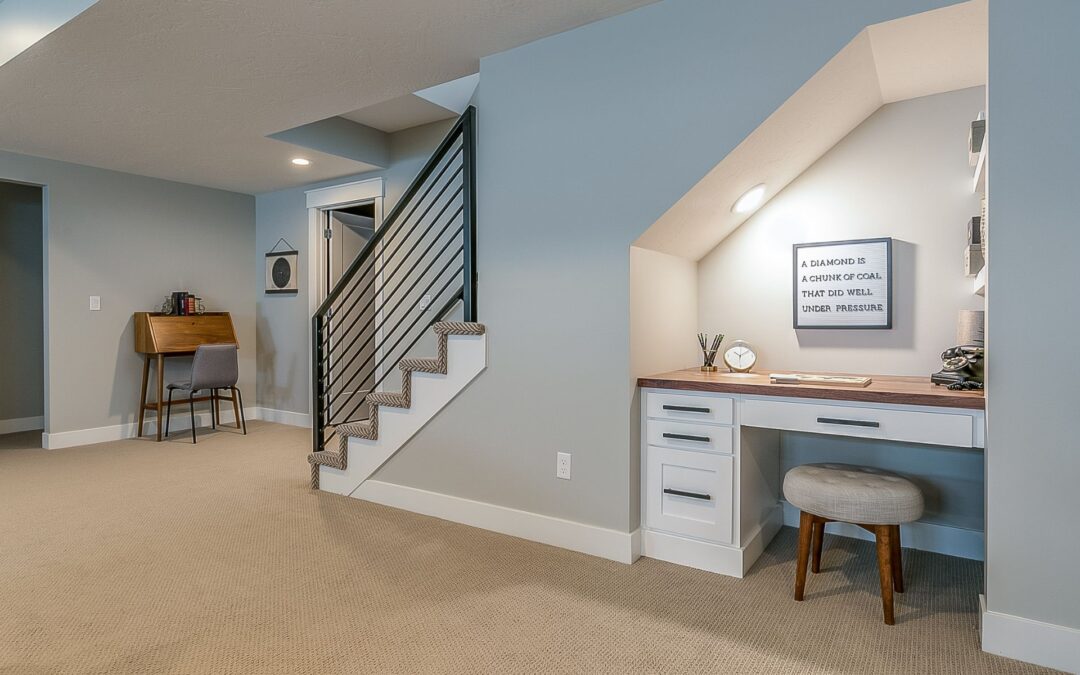Choosing the right paint color for your basement can make a huge difference in transforming the space from a dark, overlooked area into a vibrant, inviting part of your home. Since basements often lack natural light and can feel closed off, selecting the right colors can brighten the area and create the perfect ambiance. Here are some helpful tips to keep in mind when choosing basement paint colors to maximize style and comfort.
1. Consider the Amount of Natural Light
Most basements don’t have a lot of natural light, which can make the space feel dark or gloomy. Because of this, you’ll want to choose paint colors that brighten the area and reflect the limited light available.
- Light and neutral colors are your best bet for maximizing brightness. Shades like soft whites, light grays, and pale beiges reflect light and make the room feel larger and airier.
- Avoid dark shades in spaces with little natural light, as they can make the basement feel smaller and more closed off.
2. Decide on the Mood or Purpose of the Room
Before choosing a color, think about how you plan to use the basement. Different colors evoke different moods, and selecting the right one can enhance the functionality of the space.
- Entertainment or family room: For a cozy, welcoming environment, consider warm, earthy tones like soft browns, warm grays, or even muted yellows.
- Home office: If your basement will be used for work, calming colors like light blues, greens, or neutral tones can promote focus and productivity.
- Gym or workout space: Energizing colors such as fresh greens or subtle oranges can help boost energy and motivation.
- Guest room: Opt for soothing and relaxing tones like light blues, pale greens, or lavender to create a calm atmosphere.
3. Use an Accent Wall for Depth
While light colors are generally best for basements, an accent wall can add depth and personality to the space without overwhelming it. Choose a bold or darker color for one wall, while keeping the rest of the walls lighter to maintain an open, airy feel.
- Best accent wall colors: Deep blues, charcoal gray, or rich greens work well in basements and add a touch of sophistication or warmth to the room.
- Accent wall placement: The accent wall can be placed on the wall facing the entrance or behind a focal point like a TV or fireplace.
4. Choose Paint Finishes Carefully
The finish of your paint can significantly affect the overall look and feel of the basement. Since basements often experience higher humidity or moisture levels, it’s important to select a paint finish that is durable and moisture-resistant.
- Satin or eggshell finishes are great for basement walls because they have a slight sheen that reflects light, but are still easy to clean and resistant to wear and tear.
- Semi-gloss or gloss finishes are perfect for areas that need more protection, like near sinks, bathrooms, or high-traffic areas. These finishes are moisture-resistant and easy to clean.
5. Consider the Ceiling and Flooring
Don’t forget that the ceiling and floor will play a role in how your basement paint colors are perceived. A dark ceiling can make the space feel cramped, while a light-colored ceiling will make it feel more open and taller.
- White or light-colored ceilings can open up the space, making it feel more expansive.
- Flooring color should complement the wall colors. For example, if you have dark wood or tile floors, opt for lighter wall colors to balance out the overall look.
6. Create Visual Continuity with the Rest of Your Home
While your basement might serve a different purpose than other areas of your home, maintaining some continuity with your overall color scheme can create a more cohesive look throughout your house.
- Use complementary tones from other rooms to tie the basement into the overall design of the house. For instance, if you have soft blues or light grays in the upper levels of your home, consider using similar hues in the basement for visual flow.
- Accent with decor: If you prefer to go with a different palette for the basement, you can still create continuity with accent pieces like throw pillows, rugs, or artwork that reflect colors from other rooms.
7. Test Colors with Samples
Basement lighting is often artificial and can vary depending on whether you’re using warm or cool-toned light bulbs. Testing paint samples is critical to see how the color will appear under your basement’s unique lighting conditions.
- Test several shades of your chosen color on the walls and observe how the colors look at different times of the day with your lights on and off.
- Pay attention to undertones: Some paint colors can have undertones of yellow, blue, or green, which may appear more prominently in artificial light. Make sure the undertones work with the overall look you’re going for.
Conclusion: Brighten Up Your Basement with the Right Colors
Choosing the perfect paint colors for your basement can transform it from a dark, forgotten space into one of the most stylish and functional areas of your home. By considering natural light, the room’s purpose, and the overall aesthetics of your home, you can select colors that make your basement feel welcoming and spacious. Don’t forget to test your chosen shades to see how they perform under your basement’s lighting, and be sure to choose the right paint finishes for durability. With these tips, your basement will become a bright, inviting part of your home where everyone will want to spend time.



Recent Comments